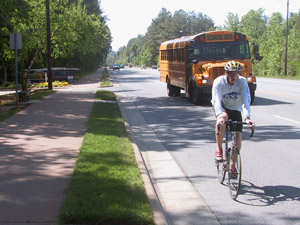

Innovating methods to improve pedestrian and bicycle safety in Chapel Hill/Carrboro
Developing a pedestrian or bicycle safety action plan involves many steps, including long-term strategic planning, while targeting pressing needs. Understanding which areas are most in need of safety improvement is essential when allocating limited resources.

www.pedbikeimages.org / Libby Thomas
In the study Identifying and Prioritizing Locations for Pedestrian and Bicyclist Safety Improvements in Chapel Hill and Carrboro, North Carolina, prepared for the N.C. Department of Transportation, researchers at the UNC Highway Safety Research Center (HSRC) take an innovative approach to identifying locations in Chapel Hill and Carrboro, N.C., that would benefit from pedestrian or bicycle safety improvements.
This type of safety assessment study is important for an area like Chapel Hill and Carrboro where walking, biking, and transit use are common, and driver commuting rates are 20 percent lower than the rest of the surrounding Triangle metro area which includes Raleigh and Durham, N.C. A series of three fatal and two non-fatal collisions involving pedestrians and bicyclists within a week in January of 2006 precipitated discussions between the two Towns and State traffic engineers that ultimately led to the study.
"Determining where crashes have already occurred is one step in the process, but proactive measures are also important in developing a comprehensive plan to address safety concerns and prevent crashes," said HSRC Research Associate Libby Thomas, an author on the study.
"New development, changes in the economy, increasing transit use, and many other factors may alter walking conditions or bicycling travel patterns so that pedestrian and bicycle safety improvements are needed in locations that have not experienced collisions previously. Simply put, people may be walking and biking, or need to walk and bike, in places where they hadn't before," said Thomas.
To quantify risk areas, the study relies on traditional crash data, recommendations by the two Towns through public input, and on an innovative survey in which users identified specific intersections or road segments that they perceived to be unsafe for pedestrians or bicyclists. Locations with high crashes and high perceived risk were first selected for further investigation. Other locations were also chosen proactively based on a mix of crash incidence, perception of risk, and public attitudes gathered through the survey.
The research team along with staff representing the DOT and both Towns then conducted qualitative audits at the chosen locations utilizing the Federal Highway Administration's Pedestrian Road Safety Audit Guidelines and Prompt Lists. Taking into consideration a variety of factors such as road design, traffic density, lighting, signals, traffic speed and volume, and the behavior of drivers, pedestrians, and bicyclists, the road safety audit team identified factors affecting the safety of a site or road segment.
Overall, eight locations received in-depth audits. For each location, the research team proposed specific safety recommendations and countermeasures for consideration by the Towns and DOT. Some improvements could be implemented quickly, such as the addition of warning signs or enhanced markings. Others improvements include longer-term treatments, such as the addition of pedestrian signals, changes in geometrics, or the addition of lighting. The study also emphasizes the need for continued assessment of other locations that did not receive audits.
The study is meant to be an integral part of the Towns' bicycle and pedestrian safety action plans that include continued monitoring of crashes and other conditions that may affect safety. Kevin Lacy, Director of Mobility and Safety at N.C. DOT, says the Department is also hoping to apply the methods developed in this study to other communities across the state as they strive to lower the incidences of pedestrian- and bicycle-motor vehicle crashes.
The University of North Carolina Highway Safety Research Center
730 Martin Luther King Jr. Blvd, Suite 300 | Campus
Box 3430 | Chapel Hill, NC 27599-3430
Phone: 919.962.2203 | Fax: 919.962.8710
http://www.hsrc.unc.edu